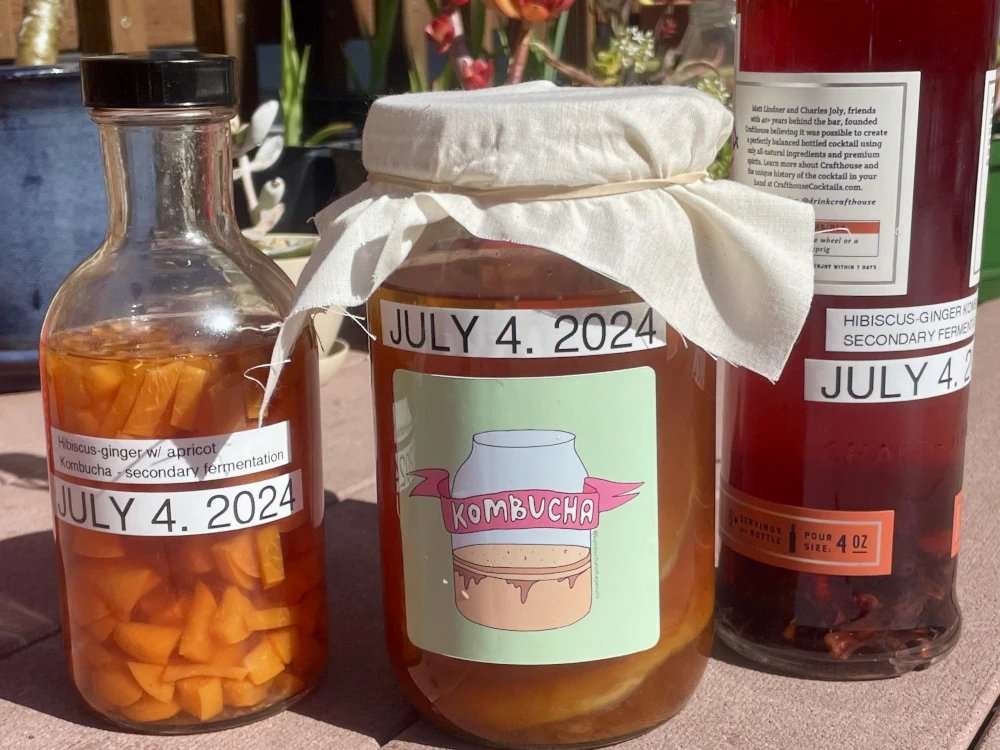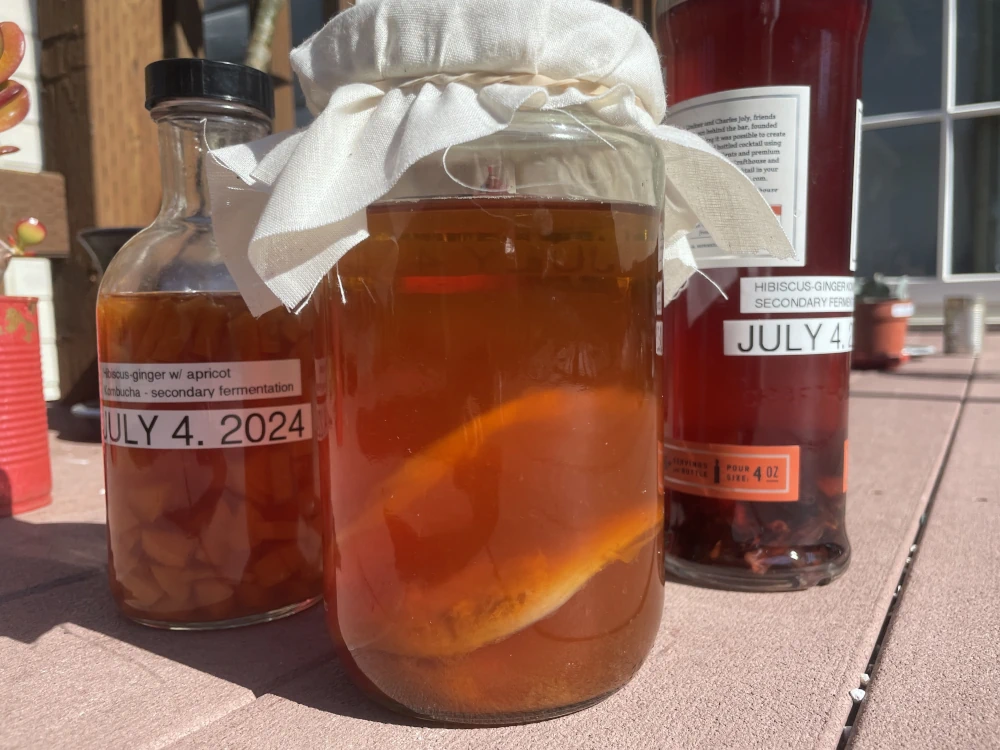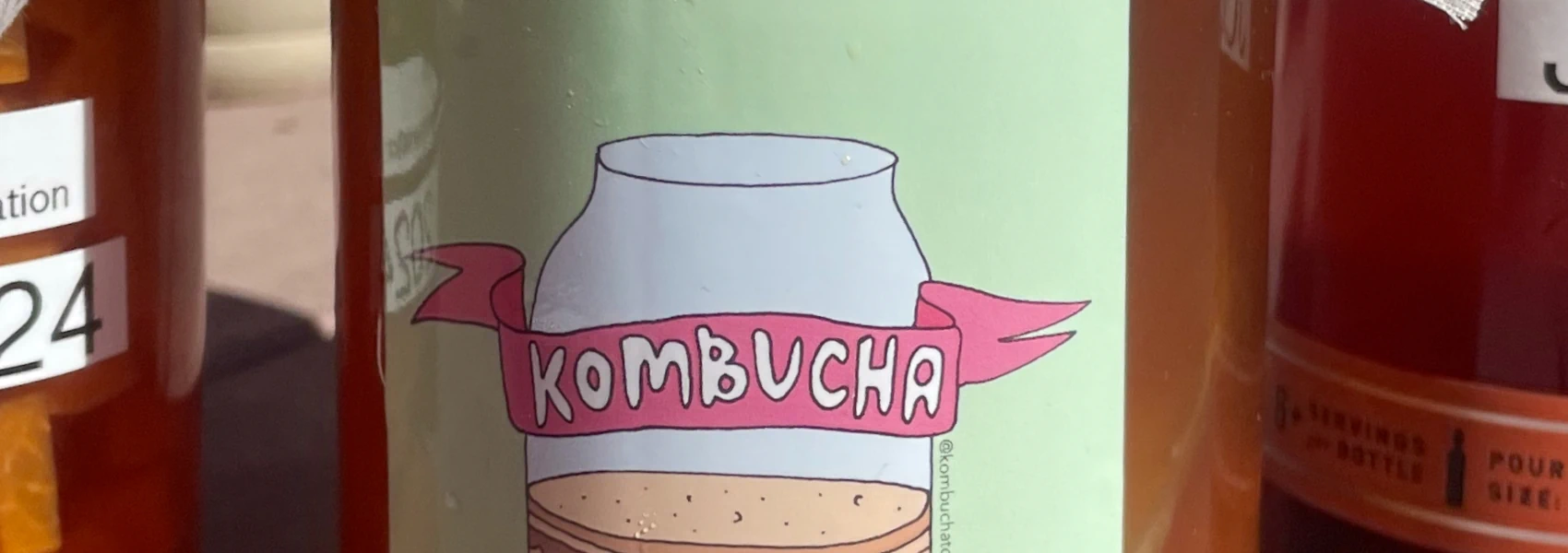Why would I want to drink rotten tea? Is what I thought, and possibly also said, the first time I heard of kombucha. Even though I happily ate and made many other fermented foods and drinks, kombucha seemed weird and gross. Honestly, I think it had a lot to do with the culture. I mean, actually, both the symbiotic culture of bacteria and yeasts and the culture of the people who made and drank kombucha. It seemed like a lot of hippies, or maybe hipters, with a disquietingly easy-going attitude to food safety loved to brew this stuff and also wanted to get you to drink some as a kind of dare. These felt like the same kind of people who would fail to pasteurize jam or drink shots of Fernet. These same people would then delightedly tell you how they got a slimy mat of mysterious symbiotes from some dude[1] on Craigslist and how it was alive and kind of gross but awesome and it's in the fridge do you want to see it, because it's actually thick enough you could have a layer and make your own, would you like one?
What the hell? No, I don't want one. And no I don't want to drink any, thanks.
Years passed and kombucha became more popular and eventually my curiosity got the better of me. While on vacation, I saw some ginger kombucha at a nice cafe. It came in a can in a fridge and seemed sanitary. I was driving and couldn't have beer but wanted sort of the feeling of drinking beer, which I thought it might give me. It was, in fact, very tasty. I've been drinking it since then, though I haven't tried making my own.
Homebrew #
Until last week, that is, when work had a kombucha-making workshop as a team-bonding activity. Everyone got a kit with the basics to make kombucha and the facilitator[2] talked us through it. Like a lot of hands-on activities, making kombucha is a lot easier to learn in person. On the one hand, it's very easy to make kombucha. On the other hand, there's a lot of little things that sound very complicated when you read about them.

A jar of primary fermentation kombucha and two bottles with flavored secondary fermentations. Don't worry, the kombucha is only on the sunny deck for this photo. It went safely indoors right after I took it.
At the end of the workshop, I had my first kombucha brew started. I carefully carried a jar of sweet tea with my own SCOBY (Symbiotic culture of bacteria and yeast) on BART. I felt like I was carrying around a science experiment. When I got home, I settled it on the counter to wait.
After seven days, I tasted it, decided it was sour enough, and split it into two bottles with different flavors for secondary fermentation. That's how you get the fizz and optionally add more flavors. Meanwhile, I started a new batch of primary fermentation with the original SCOBY plus the new layer.
It's alive!!! #
Now that I have my own kombucha, I get why the people were so excited about their gross microbial mat. When I look at these jars with amber liquid and floating bits of stuff, I feel a bit like a mad scientist or creepy witch living in a bog. And I kind of like it.

The "mother" SCOBY and the layer from the previous fermentation float together, and look a bit like an open mouth or sea creature
You can see how this might become an obsession, with jars full of murky floating bits taking over your kitchen and life. In The Art of Fermentation, Sandor Elix Katz quotes Elizabeth Hopkins who found herself a bit overwhelmed:
"At one point, I got to feeling that my fermentations were my pets, and then they were kind of taking over my life!" writes Elizabeth Hopkins, who tried maintaining eight different "kitchen pets" simultaneously before realizing that less can be more and scaling down.
Yeah, sounds like good advice. I've been reading the collected works of H.P. Lovecraft and this recurring bit of advice from The Case of Charles Dexter Ward could apply to kombucha:
"I say to you againe, doe not call up Any that you can not put downe; by the Which I meane, Any that can in Turne call up somewhat against you, whereby your Powerfullest Devices may not be of use. Ask of the Lesser, lest the Greater shall not wish to Answer, and shall commande more than you."[3]
Pet, food, or cloth? #
In addition to fermenting tea into kombucha, the SCOBY itself can be eaten, molded into objects, or even turned into a kind of cloth. It's a cellulose-based biofilm and people have experimented with making it into all kinds of materials. I can imagine a future where most of the plastic we use is bioflim grown by microbes like the kombucha SCOBY. The SCOBY is a kind of primordial substance and the more you brew with it, the more you get.

Symbiotic culture of bacteria and yeast or nameless horror from the vasty deeps?
So, you know, a shoggoth, basically:
"Formless protoplasm able to mock and reflect all forms and organs and processes—viscous agglutinations of bubbling cells—rubbery fifteen-foot spheroids infinitely plastic and ductile—slaves of suggestion, builders of cities—more and more sullen, more and more intelligent, more and more amphibious, more and more imitative—Great God! What madness made even those blasphemous Old Ones willing to use and to carve such things?"[4]
You can also compost it. I'm assured it's perfectly safe.
Late 20th century California meaning of "some dude," which could indicate a person of any gender, and implied more about their unverified reliability and perhaps a tendency to come to the door in a dirty or no shirt. ↩︎
The kombucha workshop was led by Lila Volkas, who also provided all the supplies, written instructions, and some cute kombucha art. I love crafty activities as team bonding because doing an activity together is what work is, ultimately, so it's a comfortable way to be with coworkers. However, the crafty activity is usually something everyone in the group is doing for the first time, so the normal barriers of expertise and power are easily put aside. The kombucha making workshop was exactly what I'd want from a crafty team activity. ↩︎
The Case of Charles Dexter Ward by H.P. Lovecraft. Full text at https://www.gutenberg.org/cache/epub/73547/pg73547-images.html ↩︎
At the Mountains of Madness by H.P. Lovecraft. Full text at https://www.gutenberg.org/cache/epub/70652/pg70652-images.html ↩︎
